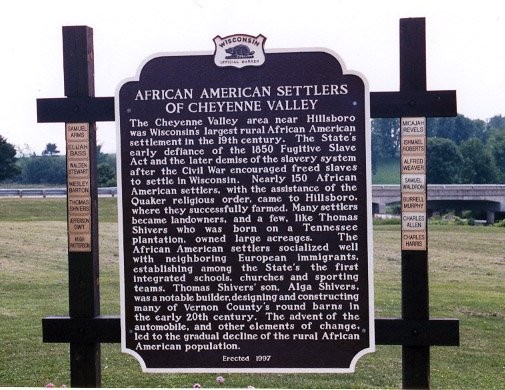African American Settlers of Cheyenne Valley
Introduction
Text-to-speech Audio
Images
Historical Marker at Cheyenne Valley

Cheyenne Valley Resident Alga Shivers

Backstory and Context
Text-to-speech Audio
Many of the former slaves and free persons of color who lived in this community traced their ancestry back to bi-racial and tri-racial communities in North Carolina and Indiana. After the Fugitive Slave Act endangered many African Americans in cities throughout Southern Indiana and Ohio, these individuals traveled to Wisconsin, often with the help of the Quakers. The African American history of the Cheyenne Valley in the 19th century was largely unknown until recent years, and the marker was erected in 1997 by the Wisconsin Historical Society.
Part of the story behind the "lost" history of this community was the gradual integration that began long before slavery and continued as these bi-racial and tri-racial people of color continued to intermarry with people of European descent. One resident was on record saying, “we didn’t even know we were integrated, we just didn’t care about color.” The inscription on the historical marker is indicative of this orientation as it devotes most of its text to listing family names and personal histories.
As an example, the marker discusses the history of the Shivers family. Thomas Shivers and his family intermarried with the neighbors and owned a significant amount of land. Shivers was a former Tennessee slave who used the Underground Railroad to escape slavery before making his way to the Cheyenne Valley. Descendent Alga Shivers later became an integral member of the community. Alga Shivers was most famously known for building, “round barns,” which were considered, “novel and progressive,” and were common in the area.
The families came to the Cheyenne Valley because the state of Wisconsin resisted the terms of the Fugitive Slave Law of 1850 which required northern states to return escaped slaves to their former owners.
Sources
Toman, William J. African American Settlers of Cheyenne Valley. hmdb.org. October 02, 2010. Accessed October 10, 2017. https://www.hmdb.org/marker.asp?marker=36398.
Earliest African American Rural Settlements in Wisconsin. Earliest African American Rural Settlements in Wisconsin. Accessed October 10, 2017. http://www.rvschools.org/faculty/jhollenberger/history/settlers/page1-5.htm.
Accessed October 10, 2017. http://csumc.wisc.edu/cmct/cheyenne/settlers.htm.
